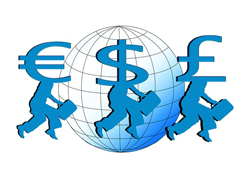 Are you thinking about setting up an e-commerce web site or selling products internationally? If so, then it’s a good idea to think about providing users with currency conversion.
Are you thinking about setting up an e-commerce web site or selling products internationally? If so, then it’s a good idea to think about providing users with currency conversion.
Currency converting software tools let your customers translate foreign currency prices into their home currency at the buying or checkout stage. It also allows visitors to see the exact amount their card or PayPal account will be charged, displayed in their local currency.
The obvious benefit of adding currency conversion is that it lets your customers view and understand prices in foreign countries in their own home currency, and makes it easier for visitors to calculate their costs and expenses.
If your site is powered by WordPress, you can add a currency converter to currency conversion to WordPress using a plugin, allowing your visitors to quickly work out the cost of your goods.
Currencyr – WP Currency Converting Plugin
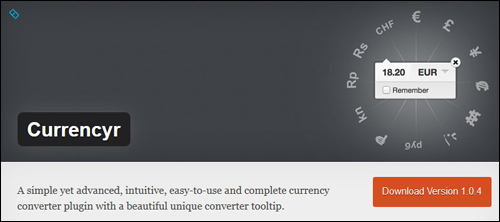
Currencyr is a simple, easy-to-use and complete currency converter WordPress plugin with a beautiful and unique converter tooltip. Best of all, it’s free!
Useful plugin features include the following:
- Inline conversion tool
- Supports a number of exchange rates providers, like Yahoo!, Google and FoxRates
- Support database cache driven for fast response
- Currency table and converter widget
- Can be integrated with various e-store plugins like WooCommerce, WP-eCommerce and Easy Digital Downloads.
- Automatically determines local currency
- Full translation support
Important: The Currencyr plugin needs your server to be running PHP 5.3.0 or later. Do not install this plugin if you currently have an older version of PHP installed on your server. Ask your web host to check and upgrade your PHP.
***
You can install the Currencyr plugin from your WP dashboard by typing in “currencyr” into the Plugins search field and clicking “Install Now” …

After you have installed and activated the plugin, you can get to the plugin’s settings section by selecting Currencyr from your WP dashboard menu …
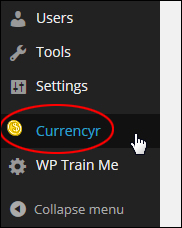
This takes you to the plugin settings section …
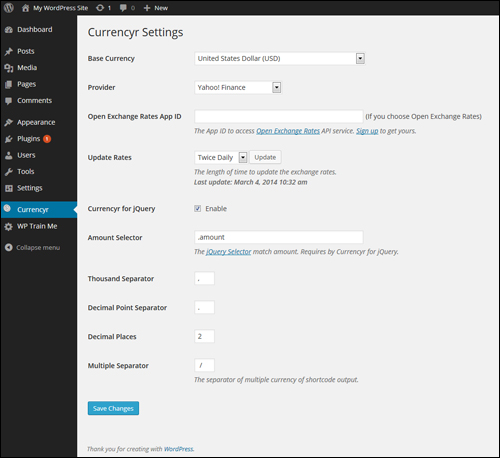
For example, you can select your base currency from the Base Currency drop-down menu if you prefer to use a different currency than the default option ‘United States Dollar – (USD)’ …
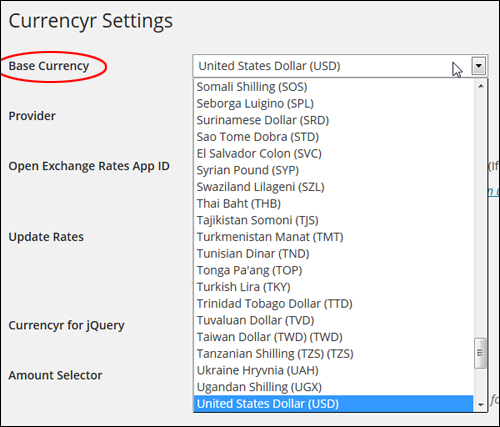
Similarly, you can specify any supported data provider from a drop-down menu. The default selection is Yahoo Finance, but you can also choose one of the other options, like European Central Bank or Open Exchange Rates …

Note: If you select ‘Open Exchange Rates’ as your provider, an API (Application Programming Interface) will be required …

You can select how often you would like to update the currency exchange rates by specifying an option from the ‘Update Rates’ drop-down menu …

The Currencyr plugin uses jQuery, which allows web developers to add things like animation effects to web applications (e.g. WordPress plugins).
If you have no reason to modify the jQuery settings, simply ignore this option …

Edit the remainder of the settings and don’t forget to click ‘Save Changes’ when finished …
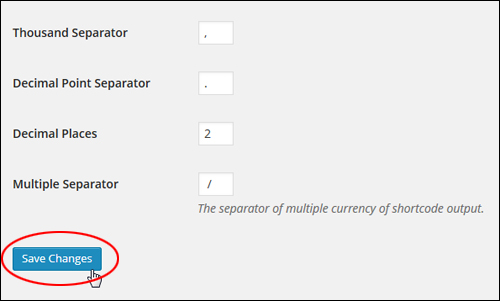
After you have finished configuring your settings, you can add currency conversion to any WordPress page or post using shortcodes.
Refer to the ‘Additional Plugin Notes’ section further below to learn how to use currency codes (e.g. USD, AUD, JPY, etc …) with this plugin.
How To Use Plugin Shortcodes
You can easily add currency conversion to WP pages, posts and widgets with no programming skills or knowledge using shortcodes.
Let’s take a look at some examples of currency shortcodes that you can add to your WP pages and posts:
Let’s say that you retail a product online for a fixed price (e.g. $175) in US Dollars (USD), and you would like to show this conversion amount in British pounds (GBP) on your page.
All you need to do is add the shortcode below into your page content …

Note: You can also display pricing in dollars and cents (for example, 188.35, 47.00, 400.00, etc …)
The example below shows how the above shortcode will look when inserting it into your page or post …
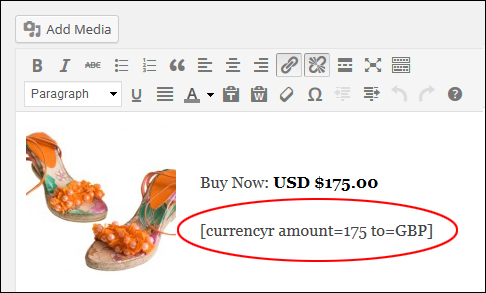
After publishing the post or page, your currency conversion will then appear like this …
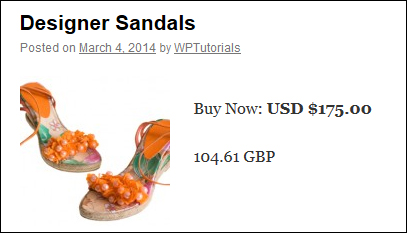
Using the same example, let’s now convert the same amount into multiple currencies.
To do this, use the shortcode shown below (add as many currency symbols as you want by using vertical pipes) …

You can see how the shortcode looks when added to your content …

After publishing your post, the converted currency will then display like this …
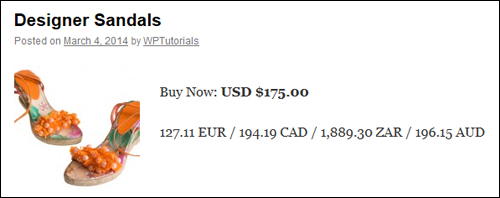
refer to the ‘Additional Plugin Notes’ section below to learn how to change the currency separator symbol in the Currencyr plugin.
Now, suppose you want to use a different base currency than the one selected as your default.
For example, if you have specified your default base currency as EUR and you have a section on your site targeted to non-European customers (e.g. Australia or Canada), you can change the base currency using the following shortcode …

The screenshot below now shows how the shortcode appears when added to a page …
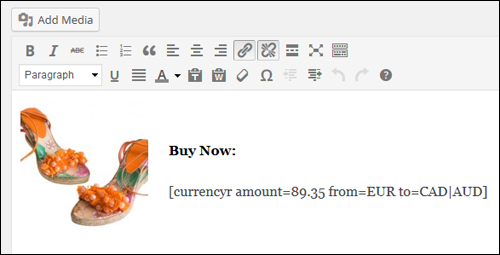
After publishing your information, the currency conversion will then display like this …
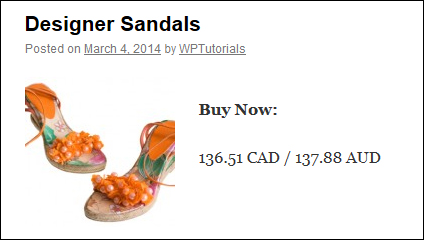
Plugin Widget
You can also add a currency converter to your website or blog’s sidebar using the plugin’s widget.
To add the currency converter to your sidebar, choose Appearance > Widgets in your WP dashboard menu …
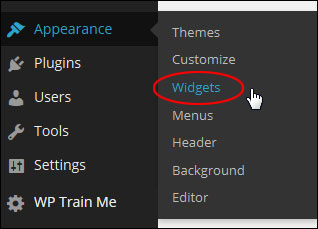
In the Widgets > Available Widgets section find the ‘Currencyr’ widget and drag it to the Active Widgets location …
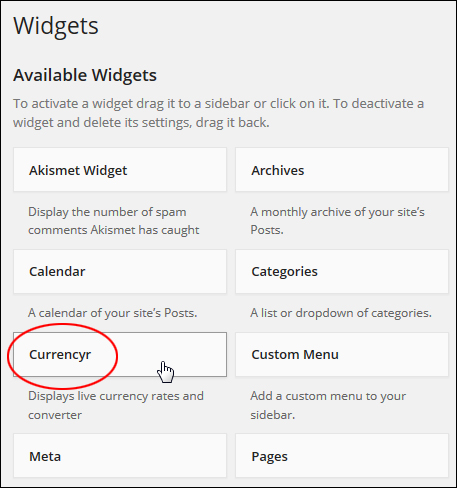
Configure the widget settings as shown below (add the currency codes you want to display on your widget separated by commas), and click Save to update your settings …
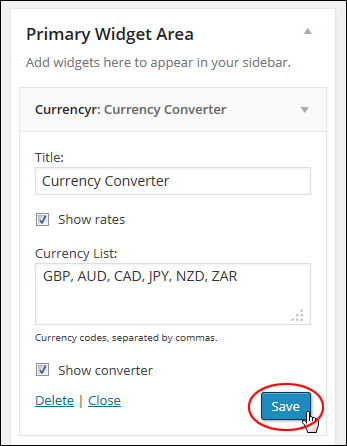
Your currency converter will now appear on your sidebar with the settings you have specified when configuring the widget …
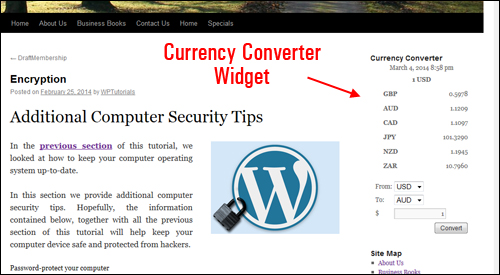
Additional Plugin Notes
This section contains additional information about using the Currencyr plugin.
Currency Separator
The Currencyr plugin lets you specify a symbol of your choice to display as the currency separator when using several currencies.
You can change the symbol in the Multiple Separator settings field.
So, for example, entering the default symbol “/” (forward slash) …

Separates all your currency values with a forward slash as shown below …
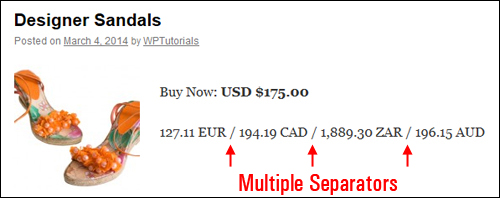
If you enter another symbol and resave your settings …

Your web visitors will see the new symbol used as the currency separator …
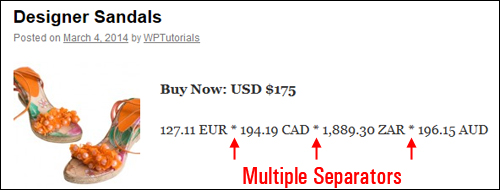
Integration With e-Commerce Software
As described earlier, the Currencyr plugin integrates with a number of WordPress-compatible e-commerce plugins like WP-eCommerce, Shopp, and Easy Digital Downloads …
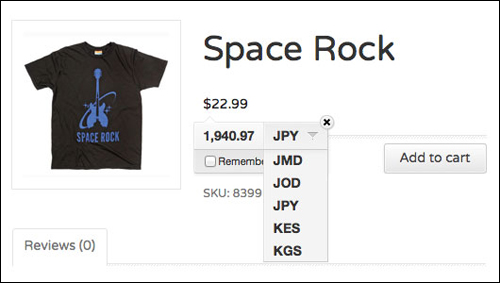
(image source: Currencyr plugin website)
And there you have it! Now you can go and easily add currency conversion to your e-commerce website.
To learn more about WordPress e-commerce plugins, see the tutorial below:
***
"I love the way your email series "Infinite Web Content Creation Training Series" is documented and presented. It is very absorbing and captivating. The links and tutorials are interesting and educational. This has motivated me to rewrite my content following the concepts I am learning from the email series." - Mani Raju, www.fortuneinewaste.com

